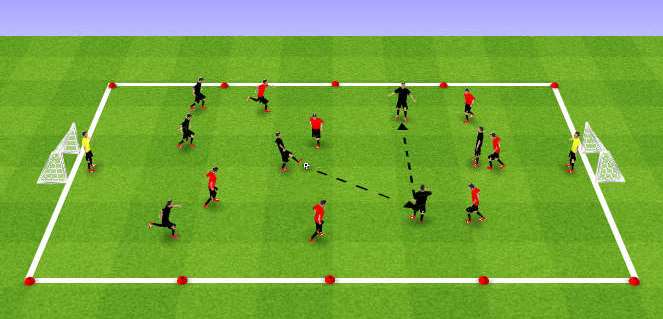
Small-Sided Brilliance: Elevating Football Performance Through Dynamic Games”
Introduction: Small-sided games are a cornerstone of effective football training, offering players the chance to develop crucial skills in a fast-paced, dynamic environment. This guide provides a collection of engaging small-sided games designed to enhance players’ decision-making, tactical understanding, and teamwork.
- 4v4 Continuous: “Fluid Possession”
- Set up a small-sided field with two teams of four players each.
- The game is continuous, with new players joining when one team loses possession or the ball goes out.
- Emphasizes quick transitions, ball retention, and adaptability.
- 3v3 with Target Players: “Connect and Score”
- Create a small-sided field with three players on each team and two neutral target players on the sidelines.
- Teams score points by connecting with the target players before attempting to score in the main goal.
- Encourages quick passes, off-the-ball movement, and utilizing wide areas.
- 2v2 Plus Goalkeepers: “Goalmouth Battles”
- Set up a goal at each end of a small field with two teams of two players each and goalkeepers.
- Teams score by successfully navigating past defenders and scoring on the opposing goalkeeper.
- Develops one-on-one skills, creativity, and finishing.
- 5v5 with Positional Restrictions: “Zone Control”
- Divide the field into zones and assign players specific positional restrictions.
- For example, forwards must stay in the attacking zone, and defenders in the defensive zone.
- Encourages positional awareness, teamwork, and effective use of playing areas.
- 3v3 Counter-Press: “Quick Turnover”
- Set up a small-sided field with three players on each team.
- Teams score by winning the ball back quickly after losing possession and scoring in the same sequence.
- Emphasizes immediate pressure, defensive organization, and rapid counter-attacks.
- 4v4 Plus Two Wide Players: “Wide Options”
- Use a small-sided field with two teams of four players each and two neutral wide players.
- Teams score points by involving the wide players in their attacks before attempting to score.
- Encourages width, crossing, and creative play in the final third.
- 2v1 Transition Game: “Numbers Advantage”
- Set up a small-sided field with two attackers against one defender.
- When the defender wins the ball, they transition quickly to attack with a numerical advantage.
- Develops decision-making under pressure, attacking creativity, and defensive resilience.
- 6v6 Continuous: “End-to-End Action”
- Create a small-sided field with two teams of six players each.
- When a goal is scored or the ball goes out, restart the game immediately to maintain a continuous flow.
- Emphasizes fitness, quick decision-making, and adaptability to changing game scenarios.
- 3v3 with Floating Goalkeeper: “Dynamic Scoring”
- Set up a small-sided field with a floating goalkeeper who plays for the team in possession.
- Teams score points by successfully converting goals when the floating goalkeeper is on their side.
- Encourages strategic use of the floating goalkeeper, quick decision-making, and finishing.
- 5v5 with Limited Touches: “Quick Transitions”
- Use a small-sided field with two teams of five players each.
- Players are limited to a certain number of touches, promoting quick ball circulation and decision-making.
- Emphasizes ball control, passing accuracy, and rapid transitions.
Conclusion: Incorporating small-sided games into training sessions is a proven method for enhancing players’ skills and understanding of the game. Coaches can adapt these games to suit their team’s specific needs, fostering a dynamic and engaging learning environment that translates to improved performance on the field.
